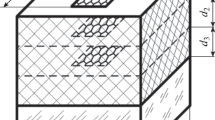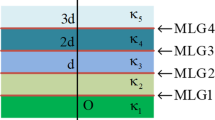Abstract
The spectrum of surface plasmon polaritons in double-layer graphene with and without an external magnetic field by utilizing Maxwell’s equations in a hydrodynamic model was studied and field configurations were analyzed. There is neither a transverse magnetic (TM) mode nor a transverse electric (TE) mode but a full-field mode under the external field. Regardless of the presence or absence of an external field, the excited transverse magnetic field is symmetrical in the acoustic branch, whereas it is antisymmetrical in the optical branch. Meanwhile, the excited transverse electric field has opposite symmetry properties against to that of the transverse magnetic field. The results indicate that the rise of the spectrum is dominated by an external magnetic field in the infrared region and a non-local effect in the ultraviolet region. The influence of the layer distance on the spectrum was also studied.










Similar content being viewed by others
Data Availability
No datasets were generated or analysed during the current study.
References
Zhang J, Zhang L, Xu W (2012) Surface plasmon polaritons: physics and applications. J Phys D Appl Phys 45(11):113001
Shkerdin G, Alkorre H, Stiens J et al (2015) Coupled TM surface plasmon features of graphene-metal layered structure in the sub-THz frequency range. J Opt 17(4):045003
Monticone F (2020) A truly one-way lane for surface plasmon polaritons. Nat Photonics 14(8):461–465
Ratnikov PV (2020) Surface plasmon polaritons in planar graphene superlattices. Phys Rev B 101(12):125301
Zhu S, Wang B, Guo B (2020) Dispersion relation of graphene surface plasmon by using a quantum hydrodynamic model. Superlattices Microstruct 142:106516
Dompreh KA, Mensah SY, Abukari SS et al (2016) Amplification of acoustic waves in armchair graphene nanoribbon in the presence of external electric and magnetic fields. Physica E 83:420–425
Kuzmin D, Bychkov I, Shavrov V (2015) Electromagnetic waves absorption by graphene-magnetic semiconductor multilayered nanostructure in external magnetic field: voight geometry. Acta Phys Pol A 127(2):528–530
Boyda DL, Braguta VV, Valgushev SN et al (2014) Numerical simulation of graphene in an external magnetic field. Phys Rev B 89(24):245404
Cosme P, Terças H (2021) Hydrodynamical study of terahertz emission in magnetized graphene field-effect transistors. Appl Phys Lett 118(13):131109
Xiang Q, Yu J, Jaroniec M (2012) Graphene-based semiconductor photocatalysts. Chem Soc Rev 41(2):782–796
Tongay S, Lemaitre M, Miao X et al (2012) Rectification at graphene-semiconductor interfaces: zero-gap semiconductor-based diodes. Phys Rev X 2(1):011002
Hu Y, Zhou C, Wang H et al (2021) Recent advance of graphene/semiconductor composite nanocatalysts: Synthesis, mechanism, applications and perspectives. Chem Eng J 414:128795
Justin Jesuraj P, Parameshwari R, Kanthasamy K et al (2017) Hole injection enhancement in organic light emitting devices using plasma treated graphene oxide. Appl Surf Sci 397:144–151
Hu M, Yan Y, Huang K et al (2018) Performance improvement of graphene/silicon photodetectors using high work function metal nanoparticles with plasma effect. Adv Opt Mater 6(9):1701243
Radsar T, Khalesi H, Ghods V (2021) Graphene properties and applications in nanoelectronic. Opt Quant Electron 53:178
Park CS, Yoon H, Kwon OS (2016) Graphene-based nanoelectronic biosensors. J Ind Eng Chem 38:13–22
Li X, Xie R, Li W et al (2019) Adjustable electromagnetically induced transparency effect based on graphene surface plasmon. Superlattices Microstruct 128:342–348
Hajati Y, Zanbouri Z, Sabaeian M (2018) Low-loss and high-performance mid-infrared plasmon-phonon in graphene-hexagonal boron nitride waveguide. J Opt Soc Am B 35(2):446–453
Iizuka H, Fan S (2013) Deep subwavelength plasmonic waveguide switch in double graphene layer structure. Appl Phys Lett 103(23):233107
Bai T, Tang Y, Hu Z-D et al (2020) High-performance sensitive TE/TM mode switch with graphene-based metal-dielectric resonances. IEEE Sens J 21(3):2791–2797
Yin X, Zhang T, Chen L, Li X (2015) Ultra-compact TE-pass polarizer with graphene multilayer embedded in a silicon slot waveguide. Opt Lett 40(8):1733–1736
Mikhailov SA, Ziegler K (2007) New electromagnetic mode in graphene. Phys Rev Lett 99(1):016803
Shkerdin G, Alkorre H, Stiens J et al (2015) Modified TM and TE waveguide modes and reflectivity by graphene layer in coupled-graphene-metal multilayer structure in sub-terahertz frequency. J Opt 17(5):055006
Chaves AJ, Peres NMR, Smirnov G et al (2017) Hydrodynamic model approach to the formation of plasmonic wakes in graphene. Phys Rev B 96(19):195438
Ferreira BA, Amorim B, Chaves AJ et al (2020) Quantization of graphene plasmons. Phys Rev A 101(3):033817
Hua X, Sun D, Zhang X et al (2023) Modified dispersion for graphene plasmon polariton in hydrodynamic model without potential notation. Solid State Commun 369:115199
Malekabadi A, Charlebois SA, Deslandes D (2013) Parallel plate waveguide with anisotropic graphene plates: effect of electric and magnetic biases. J Appl Phys 113(11):113708
Iorsh IV, Shadrivov IV, Belov PA et al (2013) Tunable hybrid surface waves supported by a graphene layer. JETP Lett 97:249–252
Xu G, Cao M, Liu C et al (2016) Tunable surface plasmon-polaritons in a gyroelectric slab sandwiched between two graphene layers. Optics Commun 366:112–118
Toscano G, Raza S, Jauho AP et al (2012) Modified field enhancement and extinction by plasmonic nanowire dimers due to nonlocal response. Opt Express 20(4):4176–4188
Ukhtary SSR (2020) Surface plasmons in graphene and carbon nanotubes. Carbon An International Journal Sponsored by the American Carbon Society 167(1):455–474
Bludov YV, Ferreira A, Peres NMR et al (2013) A primer on surface plasmon-polaritons in graphene. Int J Mod Phys B 27(10):1341001
Funding
This research did not receive any specific grant from funding agencies in the public, commercial, or not-for-profit sectors.
Author information
Authors and Affiliations
Contributions
X.H. was responsible for Methodology, Software, Investigation, Formal Analysis and Writing - Original Draft; D.X. was responsible for Data Curation and Resources; D.L. was responsible for Conceptualization, Funding Acquisition, Supervision and Writing-Review & Editing; N.M. was responsible for Validation, Visualization and Writing - Review & Editing. All authors reviewed the manuscript.
Corresponding author
Ethics declarations
Competing Interests
The authors declare no competing interests.
Additional information
Publisher's Note
Springer Nature remains neutral with regard to jurisdictional claims in published maps and institutional affiliations.
Rights and permissions
Springer Nature or its licensor (e.g. a society or other partner) holds exclusive rights to this article under a publishing agreement with the author(s) or other rightsholder(s); author self-archiving of the accepted manuscript version of this article is solely governed by the terms of such publishing agreement and applicable law.
About this article
Cite this article
Hua, X., Sun, D., Liu, D. et al. The Double-Layer Graphene Surface Plasmon-Polaritons Spectrum in Hydrodynamic Model. Plasmonics (2024). https://doi.org/10.1007/s11468-024-02368-4
Received:
Accepted:
Published:
DOI: https://doi.org/10.1007/s11468-024-02368-4




